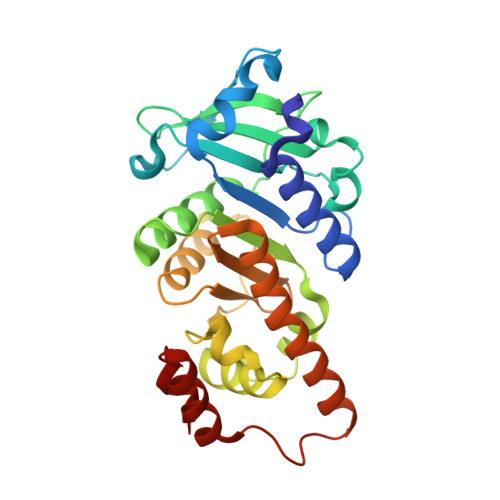Antenna Domain Mobility and Enzymatic Reaction of L-Rhamnulose-1-Phosphate Aldolase.
Grueninger, D., Schulz, G.E.(2008) Biochemistry 47: 607
- PubMed: 18085797
- DOI: https://doi.org/10.1021/bi7012799
- Primary Citation of Related Structures:
2V29, 2V2A, 2V2B - PubMed Abstract:
The enzyme l-rhamnulose-1-phosphate aldolase from Escherichia coli participates in the degradation pathway of l-rhamnose, a ubiquitous deoxy-hexose. It is a homotetramer of the rare C4-symmetric type with N-terminal domains protruding like antennas from the main body. A mobility analysis of the enzyme gave rise to the hypothesis that an anisotropic thermal antenna motion may support the catalysis (Kroemer et al., Biochemistry 42, 10560, 2003). We checked this hypothesis by generating four single mutants and one disulfide bridge that were designed to reduce the mobility of the antenna domain without disturbing the chain-fold or the active center. The catalytic rates of the mutants revealed activity reductions that correlated well with the expected antenna fixation. Among these mutants, K15W was crystallized, structurally elucidated, and used as a guide for modeling the others. The structure confirmed the design because the mutation introduced a tight nonpolar contact to a neighboring subunit that fixed the antenna but did not affect the main chain. The fixation was confirmed by a comparison of the anisotropic B-factors describing the mobility of the domains. It turned out that the distinctly anisotropic mobility of the wild-type antenna domain has become isotropic in K15W, in agreement with the design. We suggest that, like K15W, the other mutations also followed the design, validating the correlation between antenna mobility and activity. This correlation suggests that the domain mobility facilitates the reaction.
Organizational Affiliation:
Institut für Organische Chemie und Biochemie, Albert-Ludwigs-Universität, Albertstrasse 21, 79104 Freiburg im Breisgau, Germany.


















